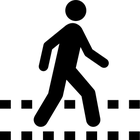Shanghai Street View: Scary Sidewalks

A recent story about a group of stubborn street vendors in the Zhabei and Baoshan districts got me thinking about the broader problem of sidewalk clutter in China, a seemingly mundane topic but one that Shanghai really needs to address as it tries to transform into a modern, cutting-edge city. Vendors of this type are all too familiar not only in Shanghai but throughout China, and are colorful and sometimes convenient but more often just an annoying presence on the sidewalks they inhabit.
These hawkers are really just part of a broader lack of respect for Shanghai’s millions of pedestrians, who have to share their sidewalks with a wide range of obstacles one would never see in any other modern city. Those run a dizzying range, from makeshift restaurants, to vendors selling everything from slippers to handbags, along with other obstacles like parked cars and bicycle riders.
I’ll return to the bigger picture shortly, but first let’s zoom in on the latest brouhaha, which involved a group of vendors whose daily outpost in the Zhabei district came to be known as the Pengpu night market. Zhabei officials decided the market was getting out of hand, as it was creating not only a nuisance for pedestrians but was also a hazard for buses and other traffic on nearby streets.
But the resulting crackdown didn’t have much effect, as less than a month later the vendors relocated to a new location in the Baoshan district. Baoshan police then conducted their own crackdown by chasing out the vendors again, leading to speculation that the group will soon reappear somewhere else, like a sprouting weed that keeps coming back every time you think you’ve pulled it from the ground.
Anyone living in Shanghai, especially in the older Puxi part of the city, can certainly understand this situation. The area near the Hailun Lu subway station on Lines 10 and 4 near my home in Hongkou offers similar frustrations on a daily basis. The sidewalk around the station is mostly clear during the days, but gets overrun around sunset by dozens of vendors selling food, clothing, books and other items throughout the evening.
I’ll admit that I’ve purchased items from one or two vendors because they’re so convenient and their prices are usually quite cheap. But I would happily give up that slight convenience to have the street cleared of this group, which causes major congestion during the rush hour when hundreds of pedestrians are trying to use the sidewalk to walk from their nearby offices to the subway.
I certainly understand and sympathize with the difficulties face by these hawkers, most of whom come from outside Shanghai and would have trouble finding other jobs. Accordingly, I would argue that the city should take a more constructive approach and try to relocate these people to controlled areas away from the sidewalks, rather than simply chasing them away.
Such an approach would allow the vendors to continue their trade in a nuisance-free way, and could even add some color to the city if new markets were well planned and promoted. Hong Kong and Taipei could serve as good examples, as each city hosts a number of colorful and boisterous night markets that have become prime attractions for both local shoppers and tourists.
That said, I’d like to pull back to the bigger of the role of sidewalks in general and how Shanghai needs to embark on a broader campaign to clean up these walkways that should provide a haven for pedestrians on crowded city streets. Walking on Shanghai’s sidewalks often feels like navigating an obstacle course, since pedestrians need to not only avoid hawkers but also watch out for other random objects like parked cars as well as moving ones like bicycles and motorcycles.
City officials should stop and think about the Chinese word for sidewalk, renxingdao, which literally translates to “pedestrian road”. That examination should involve a broader approach, including not only bans on vehicles and hawkers, but also a widening of sidewalks that are often far too narrow for the big volume of pedestrians who use them. Such a campaign would return the sidewalks to Shanghai’s millions of pedestrians, who could enjoy moving about the city by foot rather than being on constant alert for stationary and moving obstacles.
